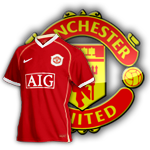During its days as Newton Heath, the club played in a number of different colours, the most recognisable being the yellow and green halved shirts worn from 1878 to 1892, and then again between 1894 and 1896; this strip was revived as an away kit in the early 1990s. Other kits worn by Newton Heath included a red and white quartered shirt (1892–1894) and a plain white shirt (1896–1902), both worn with blue shorts.[36] In 1902, in conjunction with the name change to Manchester United, the club changed their colours to red jerseys, white shorts and black socks, which has become the standard for most Man Utd home kits ever since. The most notable exception to this is the shirt that the team wore in the 1909 FA Cup Final against Bristol City, which was white with a red "V" sash.[37] This design was resurrected in the 1920s before United reverted back to the all-red shirts.
Away strips are usually white jerseys with black shorts and white socks, but other colours have been used, including a blue and white striped shirt used on-and-off from 1903 to 1916, an all-black kit in 1994 and 2003 and a navy blue shirt with silver horizontal pinstripes in 2000. One of the most famous, yet short-lived, United away kits, though, was the all grey kit from 1995–96. This kit was dropped after Manchester United failed to win a single game while wearing it. At half-time during a game against Southampton, when United were already 3–0 down, they switched to their blue and white third kit, but eventually lost 3–1. According to the players, the grey kit was not visible enough which led to the poor results.[38][39] Another famous Man Utd away kit included a reversible shirt that was white with black sleeves and gold trim on one side, and gold with black trim on the other side. This shirt was released as the last kit created by Umbro for the club before the change to Nike, and commemorated 100 years since the club had changed its name from Newton Heath to Manchester United.
The United third kit is traditionally all-blue in homage to the kit that the 1968 European Cup was won in. Exceptions to this rule have included a bright yellow kit worn in the early 1970s, the aforementioned blue and white striped shirt from 1996, which proved to be a firm favourite with the fans, and a white shirt with black and red horizontal pinstripes from 2004. United have also used what were originally used as training shirts as their third kit in the past, having adopted an all-black kit in the 1998–99 season and a dark blue shirt with maroon sides in 2001 for games against Southampton and PSV Eindhoven.
Currently, Manchester United's home jerseys are red with a vertical, white broken stripe with black trim on the reverse. The stripe is adorned with the letters MUFC at the top of the bottom portion, and a silhouette of the devil from the club badge at the top of the top portion. The AIG and Nike logos are also white. A patch with the words "The Red Devils" written in white, over an image of the club badge's devil, is attached to the bottom-left of the shirt. The club crest sits on a red kiss-cut shield on the left breast. The away kit is white with blue piping around the side and back of the neck and down the sides of the body. The trim on the front of the neck is red. The letters "MUFC" are on the back of the collar and the club badge is located on a white shield over the left breast. The third shirt is royal blue, with sponsors' logos in white. Around the club badge, which sits on a blue shield, the words "May 29th 1968 40th Anniversary" are embroidered. Like the away shirt, the letters "MUFC" are on the back of the collar, while the inside of the collar is adorned with the coat of arms of the City of Manchester, in a design inspired by the tickets used for the 1968 European Cup Final.[40] The away and third shirts are worn with blue shorts.
The Manchester United crest has been altered on a few occasions, but the basic form remains similar. The badge is derived from the crest of the city of Manchester. The devil on the club badge stems from the club's nickname "The Red Devils", which was adopted in the early 1960s after Matt Busby heard it in reference to the red-shirted Salford rugby league side.[41] By the end of the 1960s, the devil had started to be included on club programmes and scarves, before it was finally incorporated into the club badge in 1970, holding its unmistakable trident. In 1998, the badge was once again redesigned, this time removing the words "Football Club".[42] This move was met with opposition from some supporters, who viewed it as a move away from the club's footballing roots and more into the business side of the game.










Tidak ada komentar:
Posting Komentar